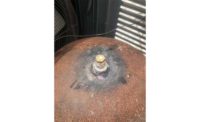Below are five actions your company can take to improve rotating-equipment maintenance:
1. Accurately align belt-driven machinery.
Many refrigeration units are powered by belt-driven machinery, which requires proper belt alignment to perform effectively. Even small amounts of angular or parallel misalignment can cause wear on pulleys and belts and trigger high vibration, resulting in possible bearing failure.
Traditionally, maintenance technicians have aligned belts and pulleys manually using straight edges and visual inspection, but this method is inexact. Modern laser-equipped belt alignment systems offer a major upgrade in accuracy. One such system, for example, consists of a laser-emitting unit, a receiver, and V-guides that position the units within pulley grooves. The operator gradually adjusts the alignment until a laser line projected by the emitting unit corresponds exactly with the other unit’s reference line. The system aligns the grooves of pulleys rather than their faces for optimal alignment.
2. Monitor erosion in electric motors.
Electric motors, especially those controlled by variable-frequency drives, can be the source of damaging electrical discharges. The discharges induce currents to travel through motor bearings, possibly resulting in lubricant breakdown and fluting damage in bearings.
Maintenance departments should monitor electrical discharges as part of preventive maintenance programs. Hand-held instruments have been introduced that allow users to detect electrical impulses without making contact with operating motors. Held at a safe distance of 18 to 24 inches from machinery, the detectors count electrical pulses for a given period and display a pulse count on the detector’s screen, alerting technicians to motor problems.
3. Improve lubrication accuracy.
Over 30 percent of all bearing failures can be traced to lubrication errors. Under-lubrication, for instance, can cause metal-to-metal contact between rotating components, resulting in premature bearing failure. The opposite condition — over-lubrication — leads to lubricant churning, high operating temperatures, and a loss of lubricant viscosity. It also wastes lubricant and increases costs.
In many refrigeration and HVAC fan applications, automatic lubricators can help eliminate both over- and under-lubrication. A successful lubricator implementation recently took place at a large general hospital in Vienna, Austria. There, 200 fans circulate chilled air through a 240,000-square-meter, 2,000-bed facility. Previously, the fans, which were manually lubricated, experienced a series of bearing failures due to under-greasing. There were also high labor costs related to manual relubing.
To prevent further bearing failures, the facility launched a pilot program covering 50 fan applications. The fans were fitted with multipoint lubricators capable of dispensing lubricant accurately though up to eight separate feed lines. The appropriate lubricant amounts and relube intervals for the 50 fans were determined and the lubricators adjusted accordingly. The lubricators each featured a central canister that held 400 milliliters of grease and could function for a full year without canister replacement.
The program, which was evaluated after six months, proved highly successful. The lubricators corrected the under-greasing problem and reduced fan bearing failures. Labor costs related to regreasing were also cut. Plans call for the facility to convert the remaining 150 fans to automatic lubrication.
4. Upgrade bearing installation.
Smaller bearings are common in refrigeration applications, and manual bearing installation remains the norm. Some manual practices, however, can damage bearings before they are even operational. One example: The use of makeshift tools, such as pipe sections, to hammer bearings onto shafts. This can transmit excessive force through the bearing’s rolling elements, damaging bearing raceways.
Fitting kits designed for mounting small bearings are a better option. They contain impact rings and sleeves sized to fit a range of smaller bearings. The impact rings and sleeves transmit mounting force to the bearing ring with the interference fit, minimizing the risk of damage. The fitting tools can also mount other components such as pulleys and seals.
5. Spot early signs of failure.
Detecting machine problems at their earliest stage enables technicians to prevent refrigeration failures and to schedule maintenance for planned shutdown periods. Advanced condition monitoring technologies make early detection easier. One helpful technology is thermal imaging, which detects infrared radiation invisible to the naked eye. The latest hand-held thermal cameras produce and display high-resolution 160-by-120-pixel images. Their sensitivity to temperature variations and ability to identify cold and hot spots in operating machinery make them ideal for use in refrigeration preventive maintenance programs.
Publication date: 03/26/2012











